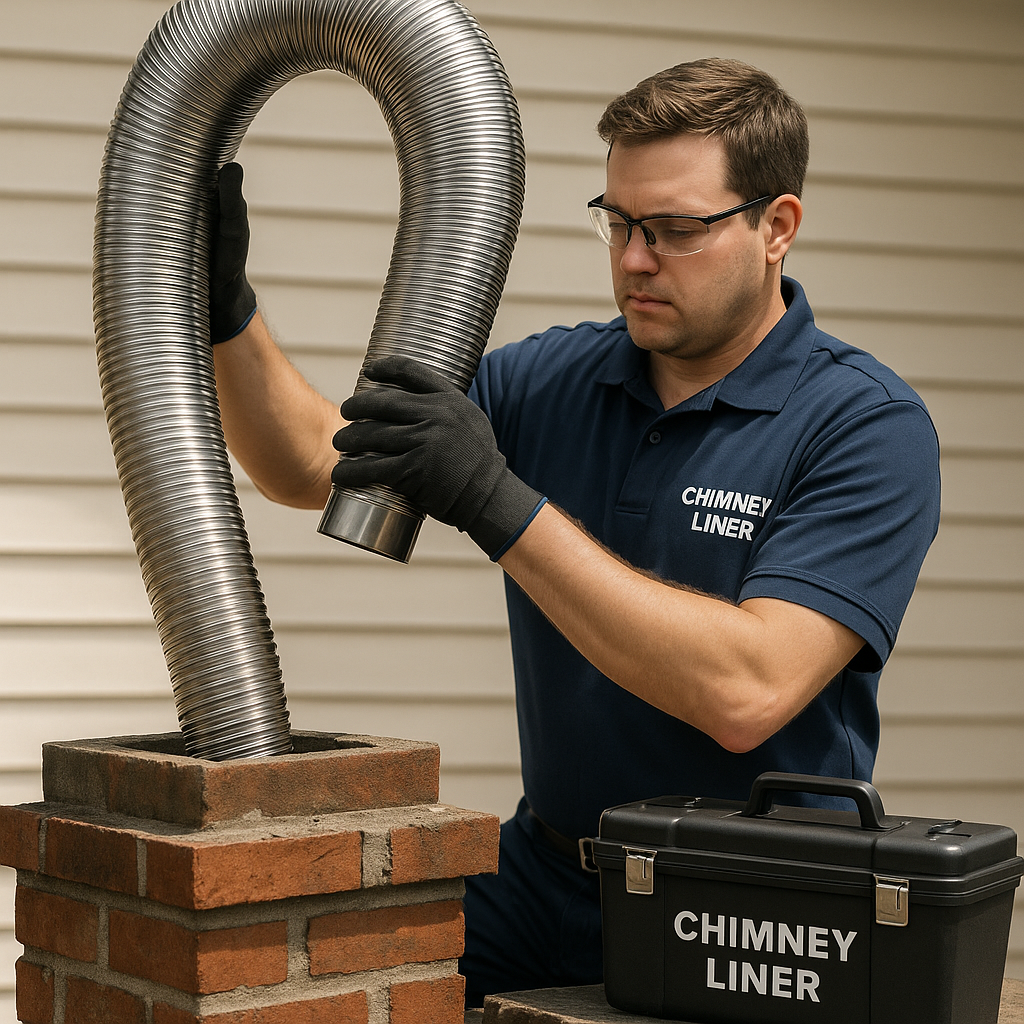Let’s face it chimneys aren’t exactly top of mind for most of us. We light a fire, feel cozy, and move on. But deep inside that brick shaft above your fireplace, something incredibly important is doing the heavy lifting: the Chimney Liner.
The Liner Lowdown: What Is It and What Does It Actually Do?
So here’s the deal. A chimney liner is like the inside skin of your chimney. It’s a layer that lines the inside of the flue (that’s the tunnel where smoke goes out). It can be made of different stuff metal, clay, or some flexible material but the goal is the same: to guide smoke and gases safely out of your house.
Think of it like a straw inside a soda can. The drink still gets to your mouth, but the straw keeps everything on track. Without it, things get messy. The liner helps protect your chimney walls from high heat, keeps nasty gases like carbon monoxide from sneaking into your home, and stops the bricks and mortar from breaking down too quickly.
If your home in Camden has an older chimney (and many do), there’s a solid chance the liner is cracked, missing, or wasn’t even installed in the first place. Not great, right?
The Camden Factor: Why Our City’s Homes Need a Bit More Care
Camden is full of character. From historic row homes to cozy old bungalows, the city has charm but that charm sometimes comes with aging infrastructure. Chimneys in older homes may have been built before modern safety codes even existed. So if you’re lighting fires without checking on that liner, you’re basically gambling with your safety.
Weather plays a role too. Cold winters in Camden mean lots of people turn to their fireplaces for warmth. When you burn wood or coal regularly, your chimney gets coated in creosote (that’s the black, tar like gunk that builds up). Without a proper liner, that stuff sticks to your bricks and increases the risk of a chimney fire. Yikes.
Types of Chimney Liners: One Size Definitely Does Not Fit All
Choosing a chimney flue liner isn’t as simple as grabbing one off a shelf. Different homes and heating systems need different solutions. Here’s a quick look at the three main chimney lining options:
| Clay Tile | Terracotta or ceramic | Traditional fireplaces in older homes | 20–30 years |
| Metal | Stainless or aluminum | Modern inserts, wood stoves, gas units | 15–25 years |
| Cast-In-Place | Cement-like mixture | Restoring old, damaged chimneys |
Type of Liner What It’s Made Of Best For Lifespan
Clay Tile Terracotta or ceramic Traditional fireplaces in older homes 20–30 years
Metal (Stainless Steel or Aluminum): Commonly used with modern inserts, wood stoves, and gas units. Typically lasts 15 to 25 years.
Cast-In-Place Cement-like mixture Restoring old, damaged chimneys 30+ years
“The best part of a cozy fire is knowing it’s safe to enjoy.”
Each has its pros and cons, but a professional can help you pick the right one based on how you use your fireplace, what kind of fuel you burn, and the shape of your chimney. In Camden, where chimney shapes can be quirky and tight, flexible metal liners are pretty popular.
How Do You Know If Your Liner’s in Trouble?
A lot of folks don’t realize they have chimney liner issues until something goes wrong. Here’s a little cheat sheet of signs that it might be time for a check-up:
Smoke starts filling your home every time you light the fireplace.
You notice crumbling bricks or chunks falling from inside the chimney
There’s a strong burnt smell, even when you’re not using the fireplace
You’ve had the chimney cleaned, but it still doesn’t “feel right”
It’s been 10+ years since anyone inspected it
If any of those ring true, it’s worth having someone come out to take a look. A chimney inspection isn’t very invasive and can catch problems before they get expensive or dangerous.
Final Thoughts: It’s What You Can’t See That Matters Most
It’s kind of wild when you think about it this one hidden tube inside your home is doing so much to keep your family safe and warm. The chimney liner is like that behind the scenes friend who’s always cleaning up your messes and making sure everything runs smoothly without ever asking for credit.
In Camden, where fireplaces are still part of everyday life for many households, checking in on your liner isn’t just smart it’s necessary. Whether you’ve just moved in or you’ve lived in your home for decades, a quick chimney inspection and, if needed, a new liner can bring a lot of peace of mind.
So go ahead. Light the fire, sip that hot chocolate, wrap yourself in a blanket but make sure your chimney’s ready to keep up.
Key Features
A good chimney liner should handle high temperatures, resist corrosion, and fit snugly inside the chimney. Metal liners (especially stainless steel ones) are often recommended for their flexibility and durability, especially in Camden’s older brick chimneys. Some come insulated for extra protection.
Safety
Liners are your first line of defense against chimney fires and harmful gases. Without one or with a damaged one carbon monoxide can seep into your home, or heat can crack the chimney walls. A well-installed liner drastically reduces both risks. It also prevents creosote from building up too quickly, lowering fire hazards.
Cost
Prices vary depending on the liner type, chimney size, and how much repair is needed. In Camden, expect anywhere from $1,200 to $3,500 for installation. Metal liners tend to be pricier up front but save money long term due to lower maintenance. Always ask for a full quote, including labor and materials.
Emergency Service
If you’ve had a chimney fire, sudden blockages, or suspect liner damage after a storm, don’t wait. Plenty of chimney experts in Camden provide emergency inspections and repairs, often showing up within just 24 hours. Your safety and air quality shouldn’t be put on hold.
If you’re unsure where to start, a chimney sweep or inspection is the first step. They’ll be able to tell you what kind of liner you have (if any), what condition it’s in, and what to do next. Think of it like taking your chimney to the doctor it’s all about prevention.
Read More : Camden Chimney Sweep

